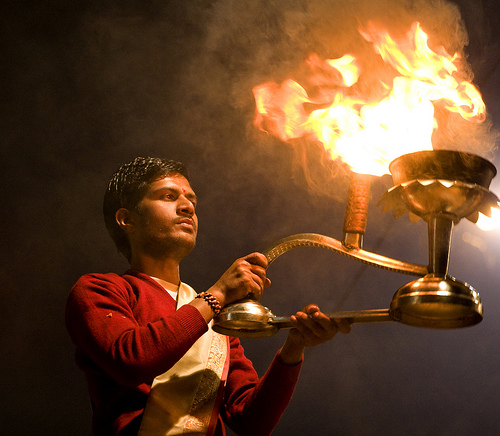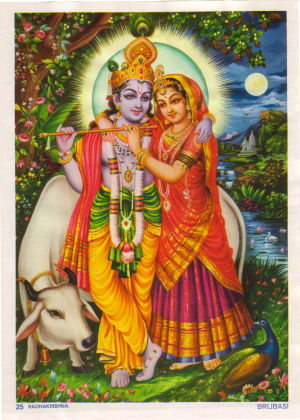
Varanasi from the train (its the blurry strip in the middle).
Arrived this morning in Varanasi from Calcutta and booked into Hotel Alka over-looking Mir Ghat on the Ganges. Varanasi (or Benares, its Muslim name) is made up of the names of two rivers, the Varana and the Assi which join the Ganges on the north and south borders of the city.
Shasti Brata in his India The Perpetual paradox,(1985) describes Varanasi as “the oldest continual living city in the world at an age reckoned to be a little under 3000 years. He calls the city where Hindus “go to die” as the “city of burning and learning, where metaphor and reality interweave to form the tapestry of living history.”
It is believed that anyone who dies in Varanasi will attain moksha or freedom from the cycle of birth and rebirth (samsara) and attain the highest spiritual reality. This is why many old people come here to die and even more will be brought here to be cremated along the banks of the Ganges.
Originally the city was known as Kashi, the City of Light, as it was believed that the jyotirlinga,

Varanasi from a boat
Shiva’s fiery pillar of light (a story found in the Shiva Purana, amongst other sources), came through the earth and flared up into the sky here.
The Kashi Vishvanatha Temple is also here. This is one of the most famous and ancient Shiva Temples in India but non-Indians do not have access to it. The security surrounding the temple is very evident with many armed guards at each entrance. Apparently this has to do with raised Muslim Hindu tensions in the area and not a zealous attempt to keep white-skins out.
Old compulsively-obsessive-temple-destroyer Aurangzeb himself destroyed this temple too in 1669 and constructed Gaynvapi Mosque right beside it, where the mosque remains today. The temple had been destroyed and rebuilt many times before this, but the current temple was built by Ahilya Bai Holkar of Indore in 1780.

Panoramic Ganges view from Hotel Alka
It rained heavily shortly after arriving so it wasn’t until this evening that some sense of Varanasi beyond the labyrinth of narrow alley-ways and Indian hustle and bustle emerged.
Having just returned and noticed a computer in the lobby I thought I’d post something of one of the most beautiful rituals I’ve seen yet. To those who question the point or purpose of ritual I say go to this one. It is simply an experience worth having.
Every evening at 7.30pm this ceremonial offering (aarti) to the river Ganges, considered a sacred mother to all life, takes place. The whole experience, out on the river; watching the brahmins in brilliant orange and white robes at the ghats perform with synchronised, almost dance like movements; the gentle lapping of water ; cool breezes in the darkness; hundreds of hushed pilgrims and tourists gathered around on boats and steps, made for a mood of reverential awe. It was certainly helped too by the sacred songs and mantras resonating, unusually, at a suitably devotional pitch.

Priests offering puja (worship) to the Ganges
There is Youtube clip that has footage of the ritual, though the brahmins were dressed differently that day. You can find it here.
The fires of huge lamps lit up the sky and incense and frankincense wafted through the night as people gently offered their own little flower lamps to the rippling back of Mother Ganga.

Spectacular fire lamp offering
But before I wax on too lyrically about the uplifting spirituality of the whole experience, ritual may also serve less edifying ends. A savvy and articulate youth, Raj, was my guide for the evening. He pointed to one of the eight or so brahmins lined up on the bank and said with unveiled disgust:
“You see him, the one with the balding hair, he’s not really a brahmin at all. When this puja is over he will go over there and smoke cigarettes and talk to the tourist girls”.
“So he’s a bit of an actor then? ” I said. ” Do you think he just likes to do this in front of the crowds, to be a bit of a celebrity? ”
He laughed saying ” Yes. This one he thinks he is the Michael Jackson of Varanasi.”
I ended my evening back at the hotel restaurant watching flames seemingly floating far out on the Ganges. I asked what it was and the waiter said it was a poor man’s cremation on the opposite side of the river – one who could not afford a burning on this side.
So as my Ginger and Honey and Lemon tea arrived, I watched the blazing funeral pyre from my side of the river. It looked like one of the little candle lamps offered by pilgrims at this evening’s ritual, floating far across the water. It flickered and gradually faded as Mother Ganges carried a soul home.
Tomorrow morning I will go out on a boat at dawn to see the sun rise over life and death at the Varanasi Ghats (broad steps leading down to the river for bathing). Then in the afternoon I will head for Prayag (Allahadad) and catch a night train from there to Mathura.






















